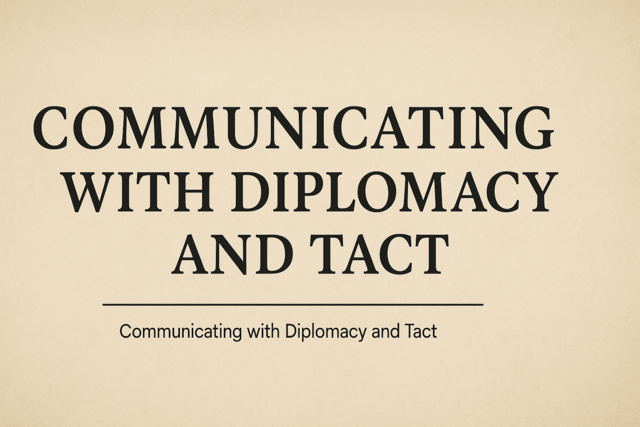In this article, we will be examining various communication behaviors that relate to communicating with diplomacy and tact. We first begin with some definitions. Scholars have defined communication in many ways over the years, but a good basic definition of communication is simply the sending and receiving of messages . When you want to send an impression, thought, or instruction, you encode your message in a combination of verbal and nonverbal cues. The person receiving this combination of verbal and nonverbal cues then is in the position of having to decode your message to ascertain what it is that you want that person to understand. Sometimes messages are decoded in the exact same way that they are encoded, which results in a successful communication exchange. This isn't always the case, however. Messages are often understood in different ways than intended. In this case, messages are not decoded in a way that coincides with their encoding, or that the sender intended. This results in a less than successful communication exchange. Encoding-decoding errors are common.
Once considered to be a series of one-way events, in which one person communicates something, then the other person returns the communication according to a sort of turn-taking, like speaking, today's communication scholars put forth a slightly different definition. Today, communication is conceptualized as the simultaneous sending and receiving of messages. This means that as you are sending messages, you are also receiving them from your audience. This then serves to inform your messaging as you adapt to the messages you are receiving from your audience. As an example, when you are telling a story, you can tell whether your audience is getting it or not by their nonverbal communication cues. As a result of what you perceive, you fine tune the way that you present your story. If you're losing them, you might try to make it more lively or speed it up. If they are right there with you, you might elaborate certain areas a bit more for an even greater response, or perhaps stretch it out a bit. In any case, you adjust the way that you tell your story based on the feedback you receive from your audience at the moment that you are telling it. In this way, communication is simultaneously sent and received.
We now begin this section with a closer look at language. Since so much of diplomacy and tact has to do with what comes out of your mouth, this seems a reasonable place to begin.
Characteristics of Language
A closer look at language reveals that it has multiple characteristics, regardless of the language that you're speaking. Firstly, language is symbolic . This means that words are intended as representatives of ideas and things. Words are learned, and are given meaning by those who use them. But a collection of sounds that forms a word does not have any inherent meaning on its own. For example, consider a table. This is the English word for a piece of furniture that has three or more legs and a flat plane on top. In Spanish, they call this a mesa; in Italian, a tavola; in German, Der Tisch, and in every other language something else. All languages have their own word for the same item. There is nothing special about the word table. It is merely a combination of sounds that come to mean a certain thing. We could just as easily have called this thing a chorate or a gundle. In this way, the word is merely a symbol to represent a thing.
Secondly, language is also arbitrary . This is partly a function of language being symbolic. Because a word is merely a symbol, any word would be just as fine as any other -- which means that it's arbitrary. Whatever symbol is chosen is not important. What matters is that the users of the symbol understand what it means. Also, words do not generally in any way look or sound like the thing that they are intended to represent. The word table doesn't look anything like a table. An exception to this is onomatopoeia, where words are intentionally derived in attempted replication of the sounds they make. Examples are meow, squish, and splash.
The third characteristic of language is that it is rule governed . You may not realize your language has a lot of rules until someone violates one. For example, in English you can say the boy kicked the ball, but you can't say the ball kicked the boy. This is because English has specific rules about subject and object positioning that, when violated, result in incomprehensibility. There are four essential rule categories for language. The first is phonology, which governs the sound system. It is here where accents reside, as well as speech impediments. The second category is semantics, which is word choice and meaning. Third is syntax, which is grammar. Syntax and semantics often go together to create meaning. For example, a well-known phrase to illustrate the interplay between syntax and semantics is colorless green dreams sleep furiously. This sentence follows the rules of syntax and is therefore grammatically correct, but breaks the rules of semantics resulting in an incorrect sentence. The reverse is also true, when the semantics holds but the syntax runs awry, as in our above example with the ball kicked the boy. Here, the semantics are fine, but the word order, the syntax, is askew which results in a grammatically incorrect sentence. The fourth rule category for language is pragmatics. This is the social function of language. Language is a social communication tool. If we lived all alone on an island with no people around, there would be no need for language. Its role is for interpersonal communication. Pragmatics governs the appropriateness of communication behaviors. For example, you wouldn't barge into a top manager's office demanding that she give you a certain book immediately. However, there are some relationships and situations in which this behavior would not be considered inappropriate -- talking to your little brother, for example. Pragmatics is the area of language with probably the least clear rules. This is in part because pragmatic rules vary by situation, so seem to be a moving target. All languages have each of these rule areas.
Fourthly, language has layers of meaning . This means that many words have certain implications that differ from their literal meanings. A denotative meaning is the definition for a word that you will find in the dictionary. For example, consider the word car. Its literal meaning is a motorized vehicle with more than two wheels that can carry at least two people. However, car might also mean independence, freedom, or social acceptance. The ideas that the word conjures comprise its connotative meaning, and a word might have different connotations to different people.
The semantic triangle was developed to represent the relationship between words and their denotative and connotative meanings. It works like this. At one point of the triangle is the word used to explain something. At another point of the triangle is the idea in the listener's mind what this word means. On the third point of the triangle is the actual thing itself. Triangle of meaning can help explain differences in language use and interpretation. For example, consider the word ball. If I asked 20 different people to imagine a ball, I'm probably going to hear at least 15 different types of balls as responses. I might hear golf ball, baseball, ping-pong ball, ball bearing, exercise ball, soccer ball, Nerf ball, whiffle ball, and the list goes on. This helps explain decoding that doesn't match coding, and results in unintended communication. When asked, you to go back into the house to grab the ball and you come out with baseball, I'm confused because I wanted you to grab the dog's ball since we are going to the dog park. But since I said park, you thought we were going to play baseball. This semantic triangle helps illustrate that meanings reside in people, not in words.
Finally, language is inherently ambiguous . Many words have multiple meanings, and many meanings depend on context. For example, if you say I saw her painting, I'm not sure if you mean a painting that she created, or if you saw her with a paintbrush in hand applying paint to some material. There are numerous examples of this, and double entendre relies on this. Also, the more concrete the word is, the less likely variation there is in its interpretation. But when we are talking about abstractions such as respect, honor, and integrity, it's much more difficult to be completely clear.
The Power of Language
Language is incredibly powerful. The name we give something, that thing becomes. For example, if a barrel is labeled "toxic waste" and presents an image of a skull and cross bones, probably not a lot of people are going to mess with it. It might be empty, but it is treated as if it is filled with toxic waste. The same is true when we talk about people. This is why derogatory terms such as white trash and ghetto damage entire groups of people when they are casually thrown around � the name we give something, that something becomes that thing, and words often have deep connotative meanings.
Language also gives us credibility, which is the degree to which we are perceived as competent and trustworthy. Credibility empowers us. Our listeners assess our credibility by our nonverbal cues and the words we choose. If we come across as un-credible, it's difficult for us to have power in a situation. But just as our words can reflect our self-uncertainty, our words can portray us as confident, trustworthy communicators. Politicians put great stock into giving the perception of credibility through their words, as well as through their actions.
Language can be used to entertain through humor, to show indirectness through euphemisms, to demonstrate group membership through slang, and to harm through libel and slander, and hate speech. More subtly, language can be used to create certain impressions in others' minds about what you think and feel about them. For example, you can choose respectful language to demonstrate that you respect the person you're speaking with, or harmful language to suggest that you do not respect or care about that person. This topic will be revisited in later chapters, but for now, it is important to recognize that the words we choose matter to our relationships and to the people who hear them.
Certain language choices lend certain impressions. For example, let us discuss the contradictor but. Grammatically, but is used to signal a contradiction in two ideas within a single sentence. That is, the second idea contradicts the first. For example, I want to go for a walk, but it's raining. The fact that it's raining contradicts and conflicts with my desire to go for a walk. In fact, because it's raining, I probably won't go for a walk right now. The weight of this sentence is on the clause it's raining. This clause dominates the meaning of the sentence and overpowers the idea of wanting to go for a walk. In this way, the second clause is often the only clause that the listener hears because the use of but signals that something bigger is about to counter the first clause. If we use the example of I love you, but you smell bad, the listener only actually hears the part about smelling bad. However, we can see that if the two clauses are flipped to read you smell bad, but I love you, the smell bad part isn't so strong. All synonyms for but behave in the same way and have the same effect: however, on the other hand, although, etc. This is an important point when it comes to communicating with diplomacy and tact. If you use the contradictor but to follow good news and deliver less-than good news, you are not optimizing this opportunity to speak with full diplomacy and tact. Instead, you're probably making the listener feel bad at least a little, which violates our definition of both diplomacy and tact which both require that the speaker instill good feelings in the listener. Instead, it's important to creatively think about how you can phrase your message without resorting to this contradictor.
The second common area of word choice challenge comes in I versus you statements. For example, the you statement would be You always leave the copier on at night because the statement begins with you as the subject. An I statement for this example would be I wish you wouldn't leave the copier on at night. Modern psychology generally suggests using I statements as opposed to you statements in an effort to avoid giving the sense of placing blame on the listener. However, a steady stream of I statements can also lend the impression of self-centeredness, as everything seems to be about what I want. In short, the situation will determine which type of statement is best, but unfortunately there is no catch-all pragmatic recommendation for this situation. Statements such as Help me understand why the photo copier is left on at night, or Do you know why the photocopier's often left on at night? or You know, leaving the photocopier on at night wastes energy and runs up the bills, can all be much more diplomatic than simply posing an I or a you statement, regardless of what comes after that, and calling it good.































